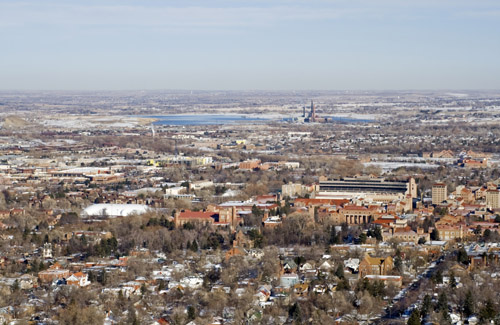
Boulder, Colorado is setting the goal that the city will be carbon neutral or, at a minimum, have an 80% decrease in Greenhouse Gas Emissions by 2050. Achieving carbon neutrality – having absolutely zero carbon foot print – involves balancing carbon released with carbon offset, or buying enough carbon credits to make up the difference.
In order to become carbon neutral by 2050, Boulder will have to make significant changes. Under its current Climate Action Plan, the city of Boulder is currently on track for a 15% increase in greenhouse gas emissions. In order to achieve carbon neutrality by 2050, Boulder would need to cut electric use by 25% by 2020 and by 50% by 2030. Residents of Boulder would have to cut their use of electricity by 87% by 2030 and reduce car use from their current average of 20 miles per day to 4 miles per day.
Although carbon neutrality is an exciting goal, some wonder whether it’s actually achievable. Roger Pielke Jr. of the University of Colorado’s Center for Science and Technology Policy Research says that with current technology and energy use, it’s just not possible. He and others feel that carbon neutrality is more a symbolic goal than a practical one due to simple logistics and available resources. Despite this sentiment, others feel that just because we don’t have the technology and energy now doesn’t mean the city of Boulder shouldn’t set carbon neutrality as a goal. Cities in Europe are already ahead of Boulder on carbon neutrality and Boulder is working with cities with similar goals in Europe as well as Portland, Oregon and Seattle, Washington to share ideas regarding reduction of greenhouse gas emissions.
Whatever the feeling about the possibility of actually achieving carbon neutrality, everyone agrees that in order to reduce Boulder’s carbon footprint, many changes need to take place. One idea involves shifting from Boulder’s heavy reliance on coal toward more renewable sources of energy. Another idea is to monitor data from the amount of energy used in Boulder to make better, more efficient use of energy. Other ideas include encouraging businesses to be energy-efficient and green as much as possible to attract more like-minded people to jobs in the city, save money and, of course, contribute to the overall goal of reducing the carbon footprint. Another idea is to create “eco districts.” This would mean dividing the goal into subsets in which neighborhoods work to reduce emissions to match the city goal – for example, if a neighborhood can be more pedestrian or bike friendly, more people will be able to walk or bike to work. If a neighborhood can work together to have collective solar panels, this can reduce emissions.
The University of Colorado Student Government has already made some progress. They set the goal of carbon neutrality in 2007 and recently reduced the net emissions of greenhouse gases to zero, a definite source of pride for the organization. To achieve their goal, they conserved energy by renovating insulation and using more efficient lighting and windows. They also generated renewable energy by installing solar panels – enough to power about 80 homes – and used carbon offset strategies. In reducing more than 90,000 metric tons of GHG emissions down to zero, the University of Colorado Student Government has demonstrated that this can be done. If Boulder keeps striving toward its goal of carbon neutrality, especially working from one neighborhood or organization to the next, it will make significant progress toward improving the environment.

